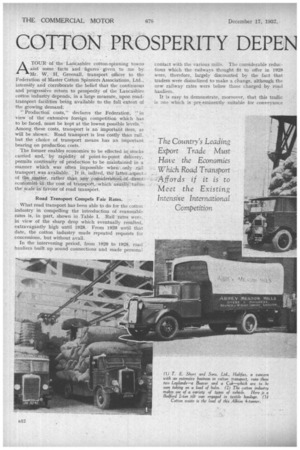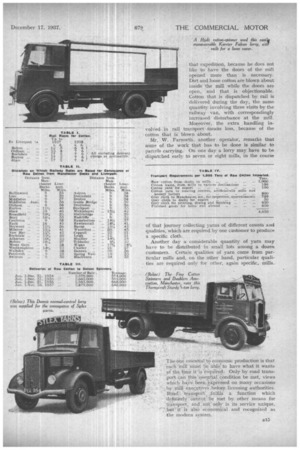COTTON PROSPERITY DEPEN
Page 12

Page 13

Page 14

Page 15

If you've noticed an error in this article please click here to report it so we can fix it.
ON MOTORS
ATOUR of the Lancashire cotton-spinning towns and some facts and figures ' given to me by . Mr. W. H. Greeriall, transport officer to the Federation of Master Cotton Spinners Associations, Ltd., intensify and corroborate the belief that the continuous and progressiv` e return to prosperity of the Lancashire cotton industry depends, in a large measure, _upon roadtransport facilities being available to the full extent of the growing demand:
"Production costs," declares the Federation, "in view of the extensive foreign competition which has to be faced, must be kept at the lowest possible levels." Among these costs, transport is an important item, as will be shown. Road transport is less costly than rail, but the choice of transport means has an important bearing on production costs.' .
The former enables economies tO be effected in stocks carried and, by "rapidity of point-to-point delivery, permits continuity of production to be Maintained in a manner which as often. impossible when-only _rail transport was available. It is indeed, the fatter aspect of tbe_ patter, rather than tkny consideration: of . dire. t _ ecoftornie in the cost of transport, which usuilv tire -4 the gcale. in favour Of road transPort.
Road Transport Compels Fair Rates.
What road transport has been able to do for the cotton industry in compelling the introduction of reasonable rates is, in part, shown in Table I. Rail rates were in view of the sharp drop which eventually resulted, extravagantly high until 1928. From 1920 until that date, the cotton industry made repeated requests for concessions, but without avail.
In the intervening period, from 1920 to 1928, road hauliers built up sound connections and made personal contact with the various mills. The considerable reductions which the railways thought fit to• offer in 1928 were, therefore, largely discounted by the fact that traders were disinclined to make a change, although the new railway rates were below those charged by road hauliers.
It is easy to demonstrate, moreover, that this traffic is one which is pre Eurther, the extended use Of toad transport has . btought about changes in business methods. Extremely small stocks are now carried in every section by the cotton .industry, with consequent economy in overhead , . expehses. . . A Lancashire haulier, asked, some years ago, to bring a load of 25 bales to a certain mill, did so promptly• and, naturally enough, asked whether there was more traffic of a similar nature. The mill owner said that a similar quantity was wanted each morning if the road haulier could tackle the work. He did so. Some months later, the mill proprietor volunteered • the information that the (to him) unexpected efficiency of delivery by road had enabled him to abandon a project involving expenditure of £2,000 on the building of a shed in which he had intended to store raw cotton. Further, he was able to put into productive capacity another shed hitherto used for storage. 'These economies, together with the saving and interest on capital outlay formerly involved in keeping stocks of raw cotton, almost paid his transport costs. -It is a fact that the nearness of the weaving Points to the spinning areas enables same-day deliveries to be effected from spinner to weaver, provided that road transport is available. The industry would be subject to considerable dislocation if restrictions on the development of road transport made these services unavailable, or available to only a limited extent. Cutting Out Rail Delays. Here, again, an example is of interest. It often happens that for a particular weaver, some half dozen different counts of yarn are needed. In the old days there as always the risk that coming by rail, one or other of these various counts would fail to arrive simultaneously with the others and production was delayed. Now a road transport contractor receives in the morning the instruction to collect given quantities of . each of the half dozen counts. He does so and delivers all of them within a few hours. Proceslure is entirely different by road from what it Wa§ by rail. Before road haulage was available, skips s13 of yarn from the spinners had to be Sent • by rail to the station nearest to the several weaving mills to which this yarn had to be delivered. The contents of the skips had then to be dissected and delivered piecemeal. The operation might take two or three days and it was during this period that a particular quality or count of yarn would fail to arrive simultaneously with the others, with the result that the mill would have to hold up production. until the missing count Could be found and delivered. The, tonnage of raw cotton-entering this country is shown in Table III. The figures, however, convey an entirely inadequatepicture of -haulage requirements. Apart from a small percentage of cotton yarn, which is re-exported, nearly all this,material -needs conveyance six times. . Many Transport Operations, The raw cotton goes first to the spinning mill. As yarn, it must then be conveyed to the weaving centres to be woven into grey cloth. As grey cloth it is, as to most of it, transferred to Manchester for inspection. Some of it is then packed and exported, but most of it must subsequently undergo printing, dyeing and finishing, all of which entail further transport. In addition, a certain amount of cotton yarn is also employed in the mixed artificial-silk trade and a fairly heavy 'tonnage is -conveyed to the Midlands for use in the hosiery trade. Table IV gives approximately the total transport requirements in tons per 1,000 tons of imported raw cotton:: Applying,thoSe.fignies to the data in Table III, it will readily be appreciated that at the present tune some 2,500,000. to fl0OOQotons of goods are in the vario% ':stages of manufacture, ;-. veyed per annum. In addition, the factories cons me approx tn ately 1,50000ct tons_ of coal -in a year. Moreover, , theindustry has an objective, in some respects indicated by the figures for the year ended Stacking cotton piece goods on mt Albion 12-ton sirran by a well-known .1-aithasAire hoof go firm. July 31, 1914, when the iniports of :raw cotton to t a 11 e cl: 4;288,060 bales; or approximately 2453,000 tons. When that to nage is again reached, Incdemand for 40,ad iransp.ort,v; ill be at least 50 per Cent. in excess of what it is to-day and Lancashire is anxious to De assured that additional tonnage will be available, Passing from the general to the par, ticular, it is of interest • .to • the• views -of some of those road operators who are directly engaged in this industry. Mr.. Samuel Cusick, who has been, engaged in the business for a good many years, uses Leyland 5-64onners and trailers.. A tyPical load delivered in my .presence comprised 85 bales of Indian cotton, weighing approximately 14 tons, which had been brought from Liverpool docks to Oldham, about 40 miles distant. He his found that secondhand Leylands of 'somewhat heavier build than the current models, formerly used for long-distance haulage, but now superseded by the • more modern. type, are satisfactory enough for this:department of Toad haulage. . Difficulty of Planning Ahead, From the operation point of view, the difficulty is that of planning transport arrangements ahead. Orders for collection and delivery come by telephone up to as late as 3 p.m. The mill owners want the cotton first thing in the morning. They cannot place instructions earlier, because of late decisions to purchase. Mr. Howarth, of Hollinwood, also uses Leylands. One of them, he says, has covered 300,000 miles and • appears good for another 300,00.0. A particular advan tage of road trans . • port fo the mill ..manager, according to Mr. Howarth, • is. that he can have • his cotton 'delivered in quantities represented by a load on a large. lorry and trailer, when the mill door opens. at 7.45 a.n, and he can complete . his acceptance of the material by -8.30 . cir9 a.m.. He "‘appteriateS that expedition, because he does not like to have the doors of the mill opened more than is necessary. Dirt and loose cotton are blown about inside the mill while the doors are open, and that is objectionable. Cotton that is dispatched by rail is delivered during the day, the same quantity involving three visits by the railway van, with correspondingly increased disturbance at the mill. Moreover, the extra handling involved . in Tail tranSportr..tneans loss, because of the cotton that is blown about. Mr, W. .Farnorth, another operator, remarks that some of the work that has to be done is similar to parcels carrying. On one day a lorry may have to tie dispatched early to seven or eight mills, in the course of that journey collecting yarns of different counts and .qualities, which are required by one customer to produce a specific cloth. Another day a• considerable quantity of yarn may have to be distributed in small lots among a dozen customers. Certain qualities of yarn come from particular mills and, on the other hand, particular qualities are required only for other, again specific; mills. , Road . transport ,..fulfils a function which definitelyl-catinotbe met by other means for tinusport, and .not2only is its service unique, but is alsoeConorniCal and recognized as the modern system.




























